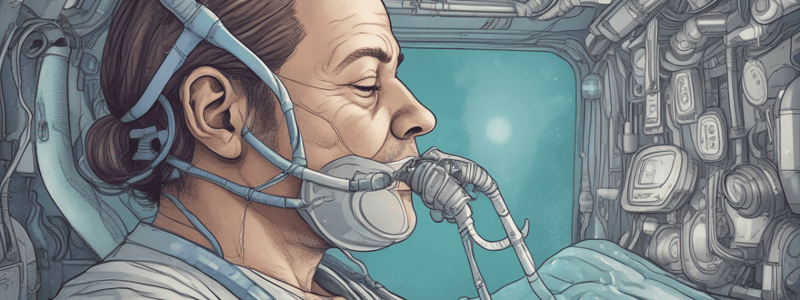Podcast
Questions and Answers
What equipment is needed for airway management?
What equipment is needed for airway management?
- Surgical scissors, IV catheters, and sterile gauze
- Blood pressure cuff, stethoscope, and ECG machine
- Oxygen mask, nasal cannula, and nebulizer
- Gill forceps, ET tubes, tube introducer, and water soluble lubricant (correct)
Which advanced airway device provides options for managing airways when traditional methods are ineffective?
Which advanced airway device provides options for managing airways when traditional methods are ineffective?
- Cricothyrotomy
- Nasal trumpet
- Combitube (correct)
- Nasopharyngeal airway
What is the pneumonic 'B magic' used for in airway management?
What is the pneumonic 'B magic' used for in airway management?
- Assessing neurological status
- Recalling steps to assist in airway management (correct)
- Remembering medication dosages
- Evaluating cardiovascular function
What should be prepared for in case of airway attempt failure?
What should be prepared for in case of airway attempt failure?
What are the confirmation devices mentioned in the text for airway management?
What are the confirmation devices mentioned in the text for airway management?
What is a treatment option for severe respiratory distress or failure as mentioned in the text?
What is a treatment option for severe respiratory distress or failure as mentioned in the text?
In emergency situations, what is preferred for providing ventilation over mouth-to-mouth?
In emergency situations, what is preferred for providing ventilation over mouth-to-mouth?
What may be a complication of using CPAP as mentioned in the text?
What may be a complication of using CPAP as mentioned in the text?
What is a component of CPAP used to provide positive end-expiratory pressure (Peep)?
What is a component of CPAP used to provide positive end-expiratory pressure (Peep)?
What action is involved in bag-valve-mask (BVM) ventilation?
What action is involved in bag-valve-mask (BVM) ventilation?
When is CPAP contraindicated according to the text?
When is CPAP contraindicated according to the text?
Study Notes
- Patients with irregular breathing patterns, altered mental status, inadequate minute volume, excessive accessory muscle use, and fatigue from labored breathing may require assisted ventilation.
- Treatment options for severe respiratory distress or failure include assisted ventilation and continuous positive airway pressure (CPAP).
- Bag valve mask (BVM) ventilation involves placing a mask over the patient's mouth and nose and squeezing the bag to assist with breathing.
- Mouth to mask ventilation and BVM are preferred over mouth to mouth for providing ventilation in emergency situations.
- BVM can deliver nearly 100% oxygen and is commonly used in prehospital and hospital settings but requires skill to master, especially in two-rescuer techniques.
- CPAP is a non-invasive means of providing ventilatory support for patients in respiratory distress by increasing lung pressure to improve oxygenation.
- CPAP is contraindicated in unresponsive patients, those with respiratory arrest, inability to protect their airway, hypoventilation, hypotension, chest trauma, or tracheostomy.
- CPAP components include a generator, mask, tubing, bacteria filter, and a one-way valve to provide positive end-expiratory pressure (Peep).
- Complications of CPAP can include claustrophobia, pneumothorax, hypotension, gastric distension, and risk of aspiration.
- Advanced Airway devices like King Airway, LMA, i-gel, Cobra periglottic Airway, and combitube provide options for managing airways when traditional methods are ineffective, with specific indications, techniques, and potential complications.- Equipment needed for airway management includes Gill forceps, ET tubes of varying sizes, stylet, tube introducer, water soluble lubricant, CC syringes, and confirmation devices such as end-tidal waveform and color metric device.
- It is important to be prepared for airway attempt failure by having alternate management devices ready, such as bougies.
- B magic is a pneumonic to remember the steps to assist in airway management: B for BVM (bag-valve-mask ventilation), pre-oxygenation, evaluating for airway difficulties, manipulating the patient if needed, watching for first-pass intubation success, using backup airways if unable, and confirming successful intubation and addressing any issues.
Studying That Suits You
Use AI to generate personalized quizzes and flashcards to suit your learning preferences.
Description
Test your knowledge on respiratory distress treatment options, including assisted ventilation, CPAP, BVM ventilation, and advanced airway devices. Explore topics such as indications, contraindications, complications, and equipment used in airway management.




